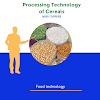MILLETS: STRUCTURE AND COMPOSITION
NTRODUCTION
The grasses known collectively as millets are a set of highly variable, small seeded plant species indigenous to many areas of the world. Millets are of value especially in semiarid regions because of their short growing season and higher productivity under heat and drought conditions. Pearl millet is the most widely grown millet and is a very important crop in India and parts of Africa. Finger millet is popular in East Africa and India. Foxtail and Proso millets are cultivated primarily in the Near East and China. Proso millet is also widely cultivated in the Russia Federation. Fonio and teff are grown in West Africa and Ethiopia, respectivelyThe millets originated primarily in East and West Africa, Eurasia, India and China from wild seed stock. Pear millet is one of the earliest domesticated millets; carbonized grains have been found in sub-Saharan and West African sites inhabited 4000- 5000 years ago.
STRUCTURE AND PHYSICAL PROPERTIES
Kernel characteristics of the various millets are extremely diverse. The millets can be divided into two types of seeds:
1. Utricles-In the utricle, the pericarp surrounds the seed like a sac but is attached to the seed at only one point. Finger millet, proso and foxtail millets are utricles. In these millets, the pericarp usually breaks away from the seed coat or testa, which is well developed, thick and forms a strong barrier over the endosperm
2. Caryopsis-. In a caryopsis, the pericarp is completely fused to the seeds. Pearl millet, fonio and teff are caryopsis. For pearl millet, the kernels are composed of the pericarp, endosperm and germ, which comprise 8.4, 75.1 and 16.5% of the total kernel weight, respectively.
The endosperm comprises the majority of the kernel weight for all millets. There are four structural parts of the endosperm: the aleurone layer and the peripheral, corneous and floury endosperm areas (Fig. 4.1). All millets have a single layer aleurone that completely encircles the endosperm. The aleurone cells are rectangular with thick cell walls, and they contain protein, oil, minerals and enzymes. The peripheral corneous and floury endosperm areas are beneath the aleurone, in that order.
Fig : structure of millet
















0 Comments
Send feedback